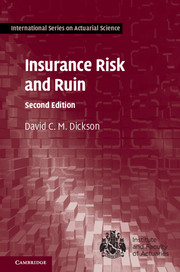Book contents
- Frontmatter
- Dedication
- Contents
- Preface
- 1 Probability Distributions and Insurance Applications
- 2 Utility Theory
- 3 Principles of Premium Calculation
- 4 The Collective Risk Model
- 5 The Individual Risk Model
- 6 Introduction to Ruin Theory
- 7 Classical Ruin Theory
- 8 Advanced Ruin Theory
- 9 Reinsurance
- Appendix
- Solutions to Exercises
- References
- Index
Preface
Published online by Cambridge University Press: 17 November 2016
- Frontmatter
- Dedication
- Contents
- Preface
- 1 Probability Distributions and Insurance Applications
- 2 Utility Theory
- 3 Principles of Premium Calculation
- 4 The Collective Risk Model
- 5 The Individual Risk Model
- 6 Introduction to Ruin Theory
- 7 Classical Ruin Theory
- 8 Advanced Ruin Theory
- 9 Reinsurance
- Appendix
- Solutions to Exercises
- References
- Index
Summary
Preface to the Second Edition
The major themes of the first edition were aggregate claims distributions and ruin theory. Since the publication of the first edition, there have been significant developments in ruin theory, most notably in the study of Gerber- Shiu functions. Consequently, the major change in this second edition is that Chapter 8, Advanced Ruin Theory, has been substantially expanded to reflect recent developments.
The other major change from the first edition is the inclusion of full solutions to exercises, which I hope will make the book more useful to undergraduate students. There are also some new exercises.
Work on this second edition was largely completed during study leave at Heriot-Watt University in the second half of 2015, and I am again grateful for the hospitality shown to me there. Thanks also to my colleague Shuanming Li for feedback on the changes to Chapters 7 and 8.
Preface to the First Edition
This book is designed for final year university students taking a first course in insurance risk theory. Like many textbooks, it has its origins in lectures delivered in university courses, in this case at Heriot-Watt University, Edinburgh, and at the University of Melbourne. My intention in writing this book is to provide an introduction to the classical topics in risk theory, especially aggregate claims distributions and ruin theory.
The prerequisite knowledge for this book is probability theory at a level such as that in Grimmett and Welsh (1986). In particular, readers should be familiar with the basic concepts of distribution theory and comfortable in the use of tools such as generating functions. Much of Chapter 1 reviews distributions and concepts with which the reader should be familiar. A basic knowledge of stochastic processes is helpful, but not essential, for Chapters 6 to 8. Throughout the text, care has been taken to use straightforward mathematical techniques to derive results.
Since the early 1980s, there has been much research in risk theory in computational methods, and recursive schemes in particular. Throughout the text recursive methods are described and applied, but a full understanding of such methods can only be obtained by applying them. The reader should therefore by prepared to write some (short) computer programs to tackle some of the examples and exercises.
- Type
- Chapter
- Information
- Insurance Risk and Ruin , pp. xi - xiiPublisher: Cambridge University PressPrint publication year: 2016



